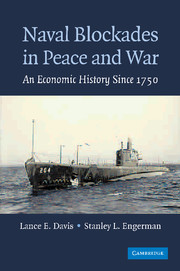Book contents
- Frontmatter
- Contents
- Preface
- 1 Introduction: “Thou Shalt Not Pass”
- 2 Britain, France, and Napoleon's Continental System, 1793–1815
- 3 The United States versus Great Britain, 1776–1815
- 4 The North Blockades the Confederacy, 1861–1865
- 5 International Law and Naval Blockades during World War I: Britain, Germany, and the United States: Traditional Strategies versus the Submarine
- 6 Legal and Economic Aspects of Naval Blockades: The United States, Great Britain, and Germany in World War II
- 7 The American Submarine and Aerial Mine Blockade of the Japanese Home Islands, 1941–1945
- 8 Blockades without War: From Pacific Blockades to Sanctions
- 9 Blockades, War, and International Law: What It All Means
- Conclusion
- Index
1 - Introduction: “Thou Shalt Not Pass”
Published online by Cambridge University Press: 18 August 2009
- Frontmatter
- Contents
- Preface
- 1 Introduction: “Thou Shalt Not Pass”
- 2 Britain, France, and Napoleon's Continental System, 1793–1815
- 3 The United States versus Great Britain, 1776–1815
- 4 The North Blockades the Confederacy, 1861–1865
- 5 International Law and Naval Blockades during World War I: Britain, Germany, and the United States: Traditional Strategies versus the Submarine
- 6 Legal and Economic Aspects of Naval Blockades: The United States, Great Britain, and Germany in World War II
- 7 The American Submarine and Aerial Mine Blockade of the Japanese Home Islands, 1941–1945
- 8 Blockades without War: From Pacific Blockades to Sanctions
- 9 Blockades, War, and International Law: What It All Means
- Conclusion
- Index
Summary
ECONOMIC WARFARE
During a war there are a number of alternative military and naval strategies that a belligerent power can pursue in that country's efforts to defeat its enemies. Obviously, one such strategy is conquest by force of arms in direct combat. Such a strategy involves the siege or the invasion of an enemy's territory, and it is aimed at the destruction, capture, or surrender of the enemy's armed forces and, perhaps, the permanent occupation of its territory. Economic warfare, by weakening the enemy's ability to pursue military action, can substitute for or complement a strategy of direct combat. Such an economic strategy is designed to sever the trading links between the enemy and his allies or with neutral powers, and, in so doing, to reduce the level of military and civilian goods that are available to support his military ventures. Historically, the blockade, usually sea-based but occasionally land-based, has been the most common form of economic warfare; however, in the more recent past, other forms of economic warfare have been utilized. They include the imposition of higher tariffs, nontariff exclusions, restrictions on capital movements, and policies aimed at encouraging the production of substitutes by the targeting and neutral nations – all tactics designed to reduce enemy exports as well as their imports. In addition, the scope of direct economic warfare has been expanded to include the aerial bombardment of economic objectives, sanctions designed to restrict trade to neutral countries, sabotage of economic targets, preemptive purchases of strategic material, and, more generally, psychological warfare.
- Type
- Chapter
- Information
- Naval Blockades in Peace and WarAn Economic History since 1750, pp. 1 - 24Publisher: Cambridge University PressPrint publication year: 2006



